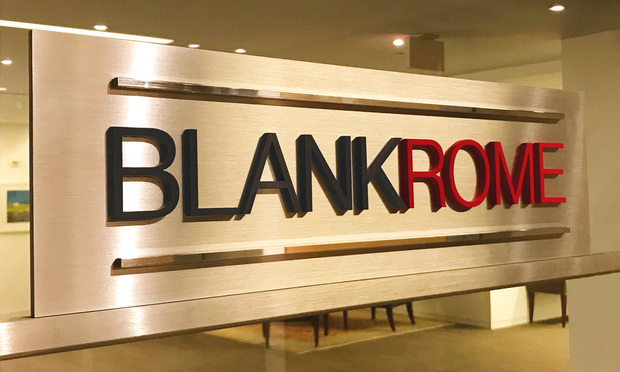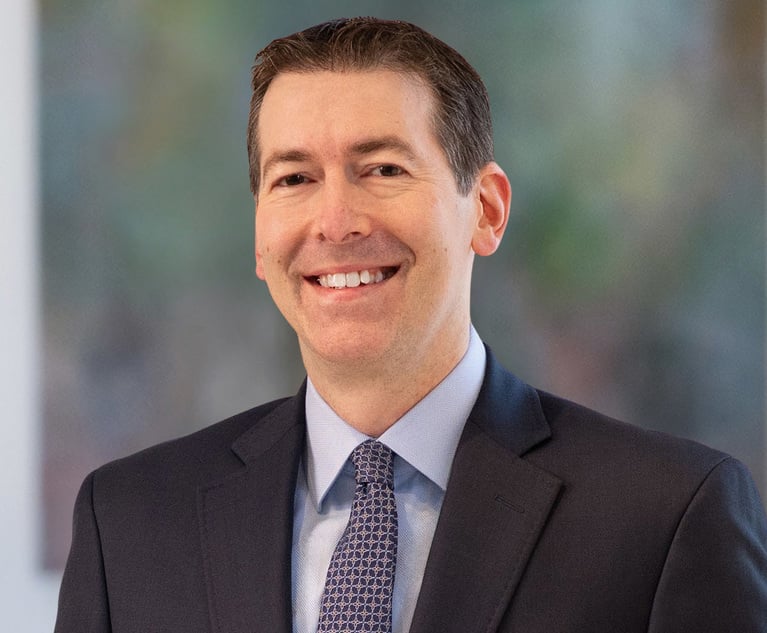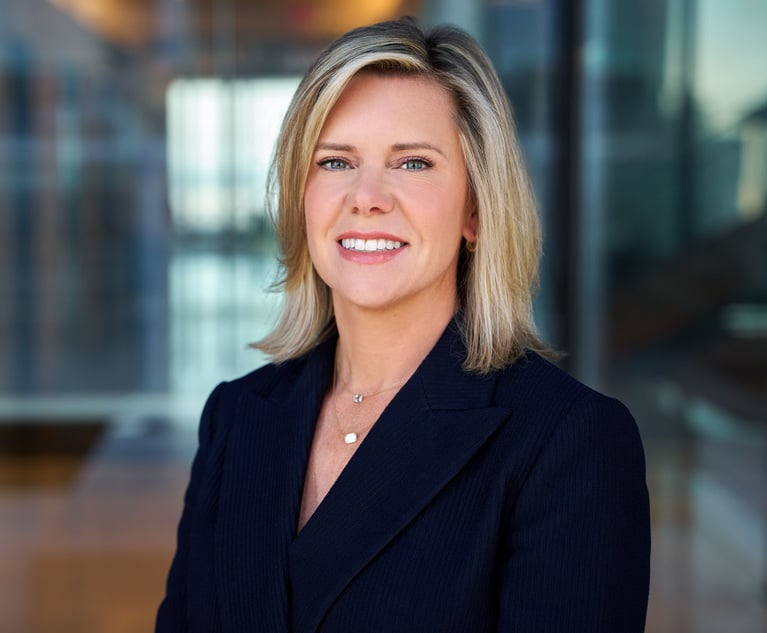Amid Split Over Strategy, Herrick Practice Leader Joins Blank Rome
Executive committee member and financial institutions group leader Stephen Brodie joined Blank Rome along with two other attorneys.
March 16, 2018 at 03:24 PM
4 minute read

Citing differences in opinion over the strategic direction of New York's Herrick Feinstein, a member of the firm's five-lawyer executive committee has left with two other attorneys to join Blank Rome.
Stephen Brodie, who joined Philadelphia-based Blank Rome this month, was co-chairman of Herrick's corporate department, chairman of its financial institutions practice group and, for the last three years, a member of Herrick's executive committee. He is joined in the move to Blank Rome by partner Julie Carvalho, in finance and restructuring, and real estate counsel Maureen O'Connor.

Brodie said Herrick's failed merger talks with Crowell & Moring indirectly led to his departure. He said after the talks broke down in March 2017, Herrick no longer sought a merger and committed to remaining an independent firm with a concentration in a few areas, including real estate and litigation, art and sports law.
“My practice could survive in a firm like that well enough, but it would thrive in a much bigger firm with geographic reach,” said Brodie, who had advocated for Herrick to merge. “I would be much better suited in a firm with a broader range of strong practice areas and bigger geographic reach.”
“I wanted to be in a firm that was large and more diverse, but I think a lot of the people who practice at Herrick didn't want that” and that may be right for those lawyers, Brodie said, adding he maintains “a lot of respect” and affection for Herrick.
Brodie, who practiced at Herrick for nearly 14 years, represents lenders in commercial real estate financing and represents banks and other financial institutions in lending money against fine art as collateral, as well as representing lenders in other transactions.
Carvalho focuses on debt financings, including middle-market transactions, art loans and other private wealth-lending transactions, mezzanine financings, and asset-based loans. O'Connor concentrates her practice on middle-market commercial loan and real estate transactions for banks.
Brodie said he spoke with other large firms after deciding to leave 120-lawyer Herrick. He said he chose Blank Rome because the firm, with 620 lawyers in 13 offices, fit the profile of what he was seeking, the firm's partners were very welcoming, and some trusted business colleagues had recommended the firm. “The reception I got here and the endorsement of these people whom I respect made it a lot easier” to switch firms, said Brodie, 67.
Brodie said most of his client matters are coming with him.
Brodie is one of about 10 partners, including some practice group leaders, to leave Herrick in 2017 and 2018. Some have joined Mintz, Levin, Cohn, Ferris, Glovsky and Popeo and O'Melveny & Myers, while others have started their own firms, including most recently Jonathan Adler and Adam Stein.
Herrick's experience with struggling to define its strategic direction, and choosing a merger and then backing out of it, can explain some departures, Brodie said.
At the same time, Herrick has made notable additions in recent months to its partnership. Last fall the firm hired Patrick O'Sullivan, former executive vice president and head of real estate transactions at the New York City Economic Development Corp., and last month it hired Morris DeFeo Jr., a key Crowell & Moring partner in the merger due diligence talks, to serve as co-chairman of its corporate practice.
DeFeo became a corporate co-chairman, alongside Stephen Jacobs, after Brodie resigned from a co-chairman position.
A Herrick spokesman on Friday did not discuss the three attorney departures but did address Brodie's statements on Herrick's strategy, defending the firm's smaller size and asserting parallels with some of New York's most elite law firms.
“After our discussions with Crowell ended, we emerged with a renewed passion for being an exceptional midsize firm, but our core practice areas remain in the areas where we have a deep bench, including lending for many large financial institutions, M&A, securities, corporate finance, fund formation, and real estate, sports, art and litigation,” the spokesman said.
“Certainly a large footprint has benefits and some firms pursue that model,” the Herrick spokesman added. “However there are many firms, including Wachtell, Lipton, Rosen & Katz; Cravath Swaine & Moore; Sullivan & Cromwell; Seward & Kissel; and Patterson Belknap Webb & Tyler, who thrive with a smaller footprint. We've managed to build a strong national and international practice without numerous offices.”
This content has been archived. It is available through our partners, LexisNexis® and Bloomberg Law.
To view this content, please continue to their sites.
Not a Lexis Subscriber?
Subscribe Now
Not a Bloomberg Law Subscriber?
Subscribe Now
NOT FOR REPRINT
© 2025 ALM Global, LLC, All Rights Reserved. Request academic re-use from www.copyright.com. All other uses, submit a request to [email protected]. For more information visit Asset & Logo Licensing.
You Might Like
View All
Orrick Hires Longtime Weil Partner as New Head of Antitrust Litigation

Attorneys ‘On the Move’: O’Melveny Hires Former NBA Vice President; MoFo Adds Venture Capital Partner
5 minute readTrending Stories
Who Got The Work
J. Brugh Lower of Gibbons has entered an appearance for industrial equipment supplier Devco Corporation in a pending trademark infringement lawsuit. The suit, accusing the defendant of selling knock-off Graco products, was filed Dec. 18 in New Jersey District Court by Rivkin Radler on behalf of Graco Inc. and Graco Minnesota. The case, assigned to U.S. District Judge Zahid N. Quraishi, is 3:24-cv-11294, Graco Inc. et al v. Devco Corporation.
Who Got The Work
Rebecca Maller-Stein and Kent A. Yalowitz of Arnold & Porter Kaye Scholer have entered their appearances for Hanaco Venture Capital and its executives, Lior Prosor and David Frankel, in a pending securities lawsuit. The action, filed on Dec. 24 in New York Southern District Court by Zell, Aron & Co. on behalf of Goldeneye Advisors, accuses the defendants of negligently and fraudulently managing the plaintiff's $1 million investment. The case, assigned to U.S. District Judge Vernon S. Broderick, is 1:24-cv-09918, Goldeneye Advisors, LLC v. Hanaco Venture Capital, Ltd. et al.
Who Got The Work
Attorneys from A&O Shearman has stepped in as defense counsel for Toronto-Dominion Bank and other defendants in a pending securities class action. The suit, filed Dec. 11 in New York Southern District Court by Bleichmar Fonti & Auld, accuses the defendants of concealing the bank's 'pervasive' deficiencies in regards to its compliance with the Bank Secrecy Act and the quality of its anti-money laundering controls. The case, assigned to U.S. District Judge Arun Subramanian, is 1:24-cv-09445, Gonzalez v. The Toronto-Dominion Bank et al.
Who Got The Work
Crown Castle International, a Pennsylvania company providing shared communications infrastructure, has turned to Luke D. Wolf of Gordon Rees Scully Mansukhani to fend off a pending breach-of-contract lawsuit. The court action, filed Nov. 25 in Michigan Eastern District Court by Hooper Hathaway PC on behalf of The Town Residences LLC, accuses Crown Castle of failing to transfer approximately $30,000 in utility payments from T-Mobile in breach of a roof-top lease and assignment agreement. The case, assigned to U.S. District Judge Susan K. Declercq, is 2:24-cv-13131, The Town Residences LLC v. T-Mobile US, Inc. et al.
Who Got The Work
Wilfred P. Coronato and Daniel M. Schwartz of McCarter & English have stepped in as defense counsel to Electrolux Home Products Inc. in a pending product liability lawsuit. The court action, filed Nov. 26 in New York Eastern District Court by Poulos Lopiccolo PC and Nagel Rice LLP on behalf of David Stern, alleges that the defendant's refrigerators’ drawers and shelving repeatedly break and fall apart within months after purchase. The case, assigned to U.S. District Judge Joan M. Azrack, is 2:24-cv-08204, Stern v. Electrolux Home Products, Inc.
Featured Firms
Law Offices of Gary Martin Hays & Associates, P.C.
(470) 294-1674
Law Offices of Mark E. Salomone
(857) 444-6468
Smith & Hassler
(713) 739-1250








